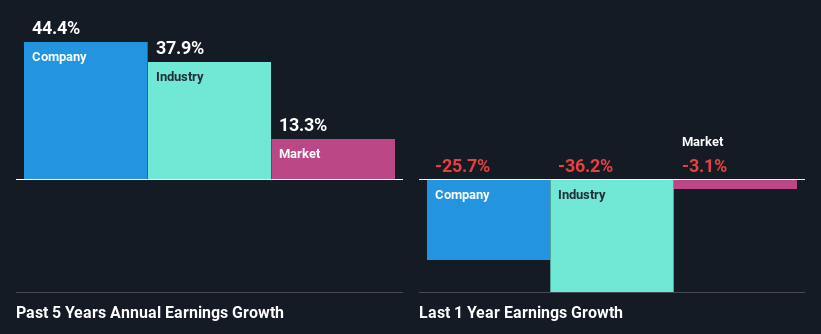Is Diamondback Energy, Inc.'s (NASDAQ:FANG) Recent Stock Performance Tethered To Its Strong Fundamentals?
Most readers would already be aware that Diamondback Energy's (NASDAQ:FANG) stock increased significantly by 33% over the past three months. Since the market usually pay for a company’s long-term fundamentals, we decided to study the company’s key performance indicators to see if they could be influencing the market. Particularly, we will be paying attention to Diamondback Energy's ROE today.
Return on equity or ROE is an important factor to be considered by a shareholder because it tells them how effectively their capital is being reinvested. In short, ROE shows the profit each dollar generates with respect to its shareholder investments.
Check out our latest analysis for Diamondback Energy
How To Calculate Return On Equity?
The formula for return on equity is:
Return on Equity = Net Profit (from continuing operations) ÷ Shareholders' Equity
So, based on the above formula, the ROE for Diamondback Energy is:
19% = US$3.4b ÷ US$18b (Based on the trailing twelve months to March 2024).
The 'return' is the amount earned after tax over the last twelve months. One way to conceptualize this is that for each $1 of shareholders' capital it has, the company made $0.19 in profit.
What Is The Relationship Between ROE And Earnings Growth?
So far, we've learned that ROE is a measure of a company's profitability. We now need to evaluate how much profit the company reinvests or "retains" for future growth which then gives us an idea about the growth potential of the company. Generally speaking, other things being equal, firms with a high return on equity and profit retention, have a higher growth rate than firms that don’t share these attributes.
A Side By Side comparison of Diamondback Energy's Earnings Growth And 19% ROE
To begin with, Diamondback Energy seems to have a respectable ROE. And on comparing with the industry, we found that the the average industry ROE is similar at 18%. Consequently, this likely laid the ground for the impressive net income growth of 44% seen over the past five years by Diamondback Energy. However, there could also be other drivers behind this growth. For example, it is possible that the company's management has made some good strategic decisions, or that the company has a low payout ratio.
As a next step, we compared Diamondback Energy's net income growth with the industry and found that the company has a similar growth figure when compared with the industry average growth rate of 38% in the same period.
The basis for attaching value to a company is, to a great extent, tied to its earnings growth. It’s important for an investor to know whether the market has priced in the company's expected earnings growth (or decline). By doing so, they will have an idea if the stock is headed into clear blue waters or if swampy waters await. Is Diamondback Energy fairly valued compared to other companies? These 3 valuation measures might help you decide.
Is Diamondback Energy Using Its Retained Earnings Effectively?
Diamondback Energy's three-year median payout ratio is a pretty moderate 37%, meaning the company retains 63% of its income. By the looks of it, the dividend is well covered and Diamondback Energy is reinvesting its profits efficiently as evidenced by its exceptional growth which we discussed above.
Besides, Diamondback Energy has been paying dividends over a period of six years. This shows that the company is committed to sharing profits with its shareholders. Based on the latest analysts' estimates, we found that the company's future payout ratio over the next three years is expected to hold steady at 43%. Still, forecasts suggest that Diamondback Energy's future ROE will drop to 12% even though the the company's payout ratio is not expected to change by much.
Summary
In total, we are pretty happy with Diamondback Energy's performance. Particularly, we like that the company is reinvesting heavily into its business, and at a high rate of return. Unsurprisingly, this has led to an impressive earnings growth. That being so, a study of the latest analyst forecasts show that the company is expected to see a slowdown in its future earnings growth. To know more about the latest analysts predictions for the company, check out this visualization of analyst forecasts for the company.
Have feedback on this article? Concerned about the content? Get in touch with us directly. Alternatively, email editorial-team (at) simplywallst.com.
This article by Simply Wall St is general in nature. We provide commentary based on historical data and analyst forecasts only using an unbiased methodology and our articles are not intended to be financial advice. It does not constitute a recommendation to buy or sell any stock, and does not take account of your objectives, or your financial situation. We aim to bring you long-term focused analysis driven by fundamental data. Note that our analysis may not factor in the latest price-sensitive company announcements or qualitative material. Simply Wall St has no position in any stocks mentioned.

 Yahoo Finance
Yahoo Finance 
